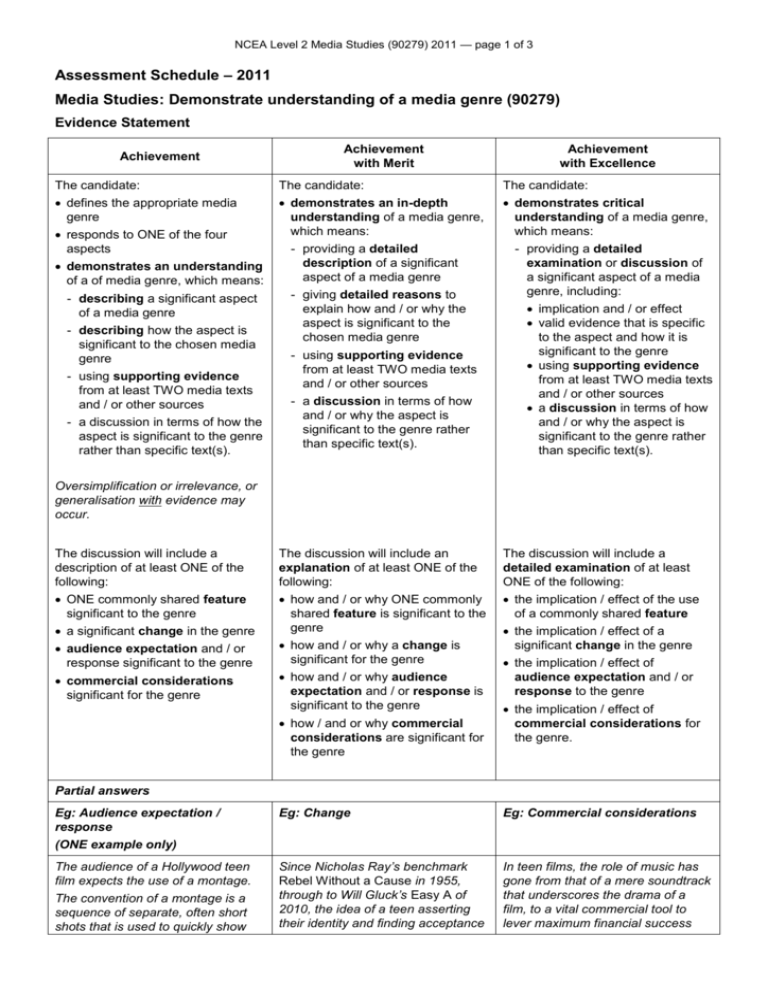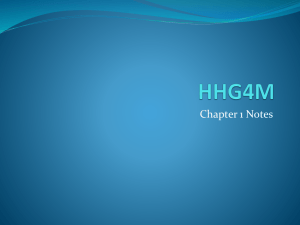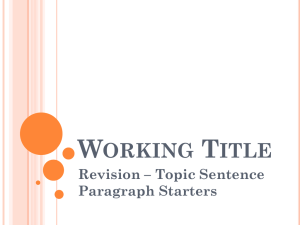Level 2 Media Studies (90279) 2011 Assessment Schedule
advertisement

NCEA Level 2 Media Studies (90279) 2011 — page 1 of 3 Assessment Schedule – 2011 Media Studies: Demonstrate understanding of a media genre (90279) Evidence Statement Achievement Achievement with Merit Achievement with Excellence The candidate: The candidate: The candidate: defines the appropriate media genre demonstrates an in-depth understanding of a media genre, which means: demonstrates critical understanding of a media genre, which means: responds to ONE of the four aspects demonstrates an understanding of a of media genre, which means: - describing a significant aspect of a media genre - describing how the aspect is significant to the chosen media genre - using supporting evidence from at least TWO media texts and / or other sources - a discussion in terms of how the aspect is significant to the genre rather than specific text(s). - providing a detailed description of a significant aspect of a media genre - giving detailed reasons to explain how and / or why the aspect is significant to the chosen media genre - using supporting evidence from at least TWO media texts and / or other sources - a discussion in terms of how and / or why the aspect is significant to the genre rather than specific text(s). - providing a detailed examination or discussion of a significant aspect of a media genre, including: implication and / or effect valid evidence that is specific to the aspect and how it is significant to the genre using supporting evidence from at least TWO media texts and / or other sources a discussion in terms of how and / or why the aspect is significant to the genre rather than specific text(s). Oversimplification or irrelevance, or generalisation with evidence may occur. The discussion will include a description of at least ONE of the following: The discussion will include an explanation of at least ONE of the following: The discussion will include a detailed examination of at least ONE of the following: ONE commonly shared feature significant to the genre how and / or why ONE commonly shared feature is significant to the genre the implication / effect of the use of a commonly shared feature a significant change in the genre audience expectation and / or response significant to the genre commercial considerations significant for the genre how and / or why a change is significant for the genre how and / or why audience expectation and / or response is significant to the genre how / and or why commercial considerations are significant for the genre the implication / effect of a significant change in the genre the implication / effect of audience expectation and / or response to the genre the implication / effect of commercial considerations for the genre. Partial answers Eg: Audience expectation / response Eg: Change Eg: Commercial considerations Since Nicholas Ray’s benchmark Rebel Without a Cause in 1955, through to Will Gluck’s Easy A of 2010, the idea of a teen asserting their identity and finding acceptance In teen films, the role of music has gone from that of a mere soundtrack that underscores the drama of a film, to a vital commercial tool to lever maximum financial success (ONE example only) The audience of a Hollywood teen film expects the use of a montage. The convention of a montage is a sequence of separate, often short shots that is used to quickly show NCEA Level 2 Media Studies (90279) 2011 — page 2 of 3 you what has happened over time. This is often used in teen films to allow for a large, and possibly boring part of the storyline to be told in an entertaining way. It uses little or no dialogue and is backed by a soundtrack – usually a song that is popular to the teen target audience. The montage is important for the genre as it is used to entertain, as well as help the audience understand the developing storyline, or set the audience up to feel a particular way about a character In John Avildsen’s 1984 teen film, The Karate Kid, the montage is used near the end of the film, and shows edited sequences of Daniel’s rise through the “All Valley Karate Tournament”, and the growing competition between him and the head Cobra Kai karate student, Johnny. The sequence is set to the soundtrack of “You’re the Best”, sung by Joe Esposito. The Karate Kid montage allows the audience to watch Daniel’s progress to the semifinals, but not have to see every fight. It is just like an inspirational music video to prepare the audience for the ultimate face-off between Daniel and Johnny at the end of the film. has been central to the plot of the Hollywood teen film genre. While this focus has not changed, who the teen needs to be accepted by and why they need to assert their identity, has definitely changed. In Rebel Without a Cause, the main teen, Jim, rebels because his mother and father fail to understand his experiences as he comes of age. The famous scene where he confronts his parents because his mother and father are always in disagreement about how he should be raised sees him cry, “You’re tearing me apart!” He confronts his mother saying, “You, you say one thing, he says another and everybody changes back again!” When Jim’s mother exclaims, “That is a fine way to behave”, he barges out of the house, kicking a hole in a family portrait. Jim’s outburst is towards the adults who fail to understand him. This lack of parental understanding of their experience and consequent conflict is typical of the traditional Hollywood teen film narrative, of the 1950s and 60s, and reflects the social change of the time. American teenage culture, as a separate experience between childhood and adulthood, was a new thing. Parents, raised in an earlier time, where children were expected to behave as children until they became adults, found it difficult to understand the problems and difficulties of 50s and 60s teens. The conflict that results from this difference in attitudes is absolutely central to the narrative of teen films. Modern teens, however, are no longer fighting against adults who do not understand them; rather the struggle in teen movies is now amongst teens themselves. The hierarchy of high school cliques sees the teen struggle with asserting their identity and along with Bring It On and Mean Girls, Will Gluck’s Easy A is a text that shows this change. from any project. There has been an enormous change from the use of soundtracks that merely heighten and underscore teen drama and angst, like the traditional score Leonard Rosenman used in Rebel Without A Cause. Warner Bros’ marketing strategy was obviously to appeal to adults, not teens, as this film has no hint of the popular rock and roll music that became so important in later teen movies. By the 1980s, the teen movie became totally targeted at teens, and the production companies did more than just add in a soundtrack that appealed to teen audiences. The soundtracks themselves became an integral part of ensuring financial success for these films, and were marketed alongside films. Kenny Loggin’s hit “Footloose” from Footloose, and Simple Minds “Don’t You forget About Me” from The Breakfast Club, were all substantial hits of the 1980s, due to the marketing and association with the films. The commercial consideration of music targeted directly at teens of the teen film was set. This link between popular music and the Hollywood teen film, would grow to be further marketed and defined in the 90s and beyond. Soundtracks are a huge part of the selling point of the modern Hollywood teen film. A vast range of popular songs are now used versus the three or so key tracks of the 1980s teen film. Teen films from the 2000s and beyond, such as High School Musical, Mean Girls and Easy A, are full of a range of songs to suit scenes or action within the film. This easy blend of the music with the teen world onscreen, such as the Natasha Bedingfield’s track “Pocket full of Sunshine” used in Easy A as part of a prop, then as the track to a montage, and later as the main character’s ringtone, talks to how music has blended with an everyday sense of teen life. And just when you thought that it was not possible to make any more money out of the songs from teen movies, the media conglomerates have now wrung many millions out of the Glee television show, reusing NCEA Level 2 Media Studies (90279) 2011 — page 3 of 3 and remarketing those same teen anthems from the genre – including “Don’t You Forget About Me” from The Breakfast Club. Today, teen genre films are the ultimate commercial tool for many companies – there is the chance to make money across many different platforms, using many different forms – the film, music videos, albums, downloads, ringtones, etc. Judgement Statement Achievement Achievement with Merit Achievement with Excellence A M E Codes C = Understanding of a media genre T = Textual evidence D = In-depth understanding of a media genre Y = Critical understanding of a media genre







